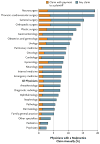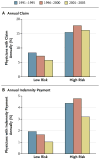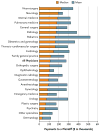Malpractice risk according to physician specialty
- PMID: 21848463
- PMCID: PMC3204310
- DOI: 10.1056/NEJMsa1012370
Malpractice risk according to physician specialty
Abstract
Background: Data are lacking on the proportion of physicians who face malpractice claims in a year, the size of those claims, and the cumulative career malpractice risk according to specialty.
Methods: We analyzed malpractice data from 1991 through 2005 for all physicians who were covered by a large professional liability insurer with a nationwide client base (40,916 physicians and 233,738 physician-years of coverage). For 25 specialties, we reported the proportion of physicians who had malpractice claims in a year, the proportion of claims leading to an indemnity payment (compensation paid to a plaintiff), and the size of indemnity payments. We estimated the cumulative risk of ever being sued among physicians in high- and low-risk specialties.
Results: Each year during the study period, 7.4% of all physicians had a malpractice claim, with 1.6% having a claim leading to a payment (i.e., 78% of all claims did not result in payments to claimants). The proportion of physicians facing a claim each year ranged from 19.1% in neurosurgery, 18.9% in thoracic-cardiovascular surgery, and 15.3% in general surgery to 5.2% in family medicine, 3.1% in pediatrics, and 2.6% in psychiatry. The mean indemnity payment was $274,887, and the median was $111,749. Mean payments ranged from $117,832 for dermatology to $520,923 for pediatrics. It was estimated that by the age of 65 years, 75% of physicians in low-risk specialties had faced a malpractice claim, as compared with 99% of physicians in high-risk specialties.
Conclusions: There is substantial variation in the likelihood of malpractice suits and the size of indemnity payments across specialties. The cumulative risk of facing a malpractice claim is high in all specialties, although most claims do not lead to payments to plaintiffs. (Funded by the RAND Institute for Civil Justice and the National Institute on Aging.).
Conflict of interest statement
No other potential conflict of interest relevant to this article was reported.
Figures




Comment in
-
Malpractice risk according to physician specialty.N Engl J Med. 2011 Nov 17;365(20):1939; author reply 1940. doi: 10.1056/NEJMc1111003. N Engl J Med. 2011. PMID: 22087697 No abstract available.
-
Malpractice risk according to physician specialty.N Engl J Med. 2011 Nov 17;365(20):1939; author reply 1940. doi: 10.1056/NEJMc1111003. N Engl J Med. 2011. PMID: 22087698 No abstract available.
References
-
- Carrier ER, Reschovsky JD, Mello MM, Mayrell RC, Katz D. Health Aff. Vol. 29. Millwood: 2010. Physicians' fears of malpractice lawsuits are not assuaged by tort reforms; pp. 1585–92. - PubMed
-
- Danzon PM. The frequency and severity of medical malpractice claims: new evidence. Law Contemp Probl. 1986;49:57–84. - PubMed
-
- Danzon P. The frequency and severity of medical malpractice claims. J Law Econ. 1984;27:115–48. - PubMed
-
- Mello MM. Research synthesis report no 10. Princeton, NJ: Robert Wood Johnson Foundation; 2006. Medical malpractice: impact of the crisis and effect of state tort reforms. - PubMed
Publication types
MeSH terms
Grants and funding
LinkOut - more resources
Full Text Sources
Other Literature Sources
